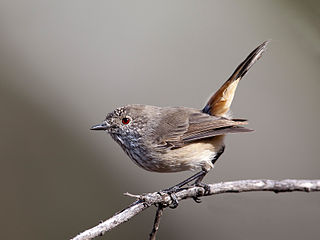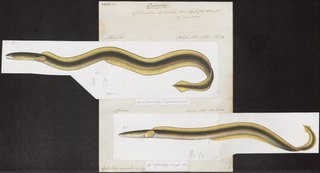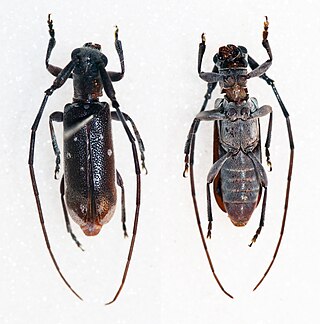
The dibbler is an endangered species of marsupial. It is an inhabitant of the southwest mainland of Western Australia and some offshore islands. It is a member of the order Dasyuromorphia, and the only member of the genus Parantechinus. The dibbler is a small, nocturnal carnivore with speckled fur that is white around the eyes.

The inland thornbill was originally described by English ornithologist John Gould in The Birds of Australia. Inland thornbills are within the order passerines. The inland thornbill belongs to the genus Acanthiza, which now has three more species than the eleven outlined by Gould in The Birds of Australia. The Noongar people of southwestern Western Australia call A. apicalis "Djoobi-Djoolbang". The inland thornbill is also known as the broad-tail thornbill and presently contains several subspecies that were once considered independent species. The word apicalis comes from the Latin for 'tipped'.

Nectomys apicalis, also known as the western Amazonian nectomys, is a semiaquatic species of rodent in the genus Nectomys of family Cricetidae. It is found east of the Andes in Ecuador, Peru, and Bolivia, east into western Brazil; further to the east, it is replaced by N. rattus. It lives near watercourses in lowland tropical rainforest. Its karyotype has 2n = 38–42, and it probably actually represents several distinct undescribed species.
Madaglymbus apicalis is a species of diving beetle. It is part of the genus Madaglymbus in the subfamily Copelatinae of the family Dytiscidae. It was described by Fairmaire in 1898. Madaglymbus apicalis is distributed along the coastlines of much of Africa.

Mimacraea apicalis, the central acraea mimic, is a butterfly in the family Lycaenidae. It is found in Nigeria, Cameroon, Gabon and the Republic of the Congo.

Dindicodes apicalis is a moth of the family Geometridae first described by Frederic Moore in 1888. It is found in Asia, including India and China.

The bluntnose snake eel is an eel in the family Ophichthidae. The author of the species is anonymous, but it has been referred to Edward Turner Bennett in 1830. It is a tropical, marine eel which is known from the Indo-Pacific, including Kenya, Madagascar, South Africa, Taiwan, Thailand, and the Philippines. It dwells at a maximum depth of 22 m, but also frequents shores. Males can reach a maximum total length of 45 cm.

Eunidiini is a tribe of longhorn beetles of the subfamily Lamiinae. It was described by Téocchi et al. in 2010.

Eunidia is a genus of longhorn beetles of the subfamily Lamiinae.
Eunidia fallaciosa is a species of beetle in the family Cerambycidae. It was described by Stephan von Breuning in 1939. It is known from Somalia.
Eunidia flavoapicata is a species of beetle in the family Cerambycidae. It was described by Stephan von Breuning in 1939.

Eunidia tripunctata is a species of beetle in the family Cerambycidae. It was described by Per Olof Christopher Aurivillius in 1911.
Eunidia plagiata is a species of beetle in the family Cerambycidae. It was described by Charles Joseph Gahan in 1898. It is known from Chad, Kenya, Zimbabwe, Mozambique, Ethiopia, South Africa, Botswana, and Tanzania.
Eunidia subtesselata is a species of beetle in the family Cerambycidae. It was described by Charles Joseph Gahan in 1909. It is known from Kenya, Ethiopia, and Somalia.
Eunidia batesi is a species of beetle in the family Cerambycidae. It was described by Olliff in 1889.
Eunidia caffra is a species of beetle in the family Cerambycidae. It was described by Fahraeus in 1872.
Eunidia nebulosa is a species of beetle in the family Cerambycidae. It was described by Wilhelm Ferdinand Erichson in 1843. It is known from Australia, Senegal, Cameroon, Gabon, the Democratic Republic of the Congo, South Africa, Madagascar, Ethiopia, Ivory Coast, Kenya, Namibia, Angola, Niger, Saudi Arabia, Somalia, Mozambique, Tanzania, and Zimbabwe.
Eunidia strigata is a species of beetle in the family Cerambycidae. It was described by Fahraeus in 1872. It contains the varietas Eunidia strigata var. damarensis.

Eunidia thomseni is a species of beetle in the family Cerambycidae. It was described by William Lucas Distant in 1898. It is known from Tanzania, Cameroon, Chad, Niger, Ethiopia, Senegal, Mozambique, Botswana, Namibia, Saudi Arabia, the Central African Republic, Somalia, Uganda, South Africa, Yemen, Kenya, and Zimbabwe.







